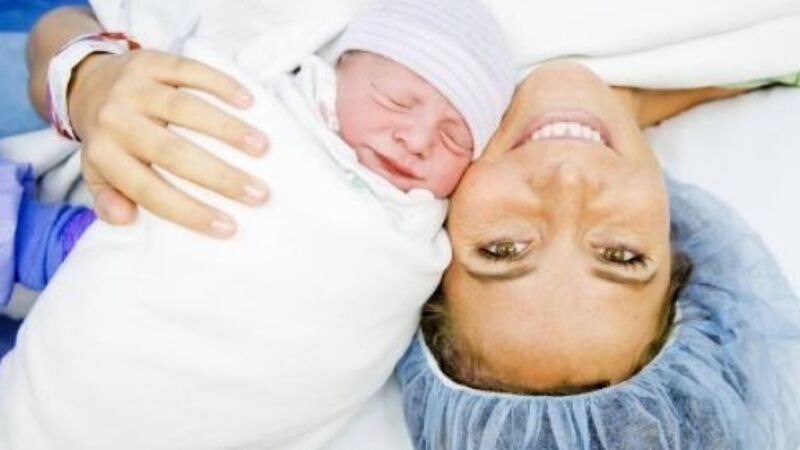C-section births: Being too posh to push really doesn't cut it

Mum of seven, , had five C-section births. Is going under the knife really the easier option?
Today is the last day of April: C-section awareness month. With C-sections now accounting for over 30% of Irish births, many myths and presumptions continue to surround the procedure. Five of my seven deliveries were via C-section which dispels one myth immediately — that three is the maximum number a woman can have.
Personally, it’s never bothered me that I have given birth via C-section so many times. I never felt that I had taken the easy option, or that I hadn’t really given birth. Medical necessity was the order of the day, rather than being “too posh to push”. The thing about C-sections and natural childbirth is that there is pain either way — all that really differs is the timing.
Then again I had already experienced natural birth, so never felt I had missed out. But what about the mums who haven’t? C-sections may be routine but that doesn’t take away from the fact that they are major abdominal surgery. A longer physical recovery is assumed but what about the emotional fallout when birth doesn’t go according to plan.

Both of Fiona McEvaddy Maher’s babies were delivered by C-section. “I experienced hypertension during my first pregnancy and I was prescribed medication which I started taking four months into the pregnancy,” she explains.
“I was hoping for a natural delivery but my blood pressure started to fluctuate. I was brought into hospital at 38 weeks to be induced but after two days of trying, labour didn’t start. Based on the advice of the medical team, I made a decision to have a c-section.”
Fiona says she felt “cheated, disappointed and at times a failure. It was my first baby, the excitement, the anticipation, the joy that surrounds the whole experience. I was fully convinced that I would have a natural delivery — baby and mother calmly working together as I had learned at the antenatal classes, but it wasn’t to be.”
When, during her second pregnancy, her blood pressure became an issue again, Fiona made the decision to have another C-section at 39 weeks. “I was more relaxed second time around as I knew what to expect,” she explains. She was also relieved to have made this decision as there was meconium in her waters when her second baby was born and the baby couldn’t breathe at birth.
“She was whisked away and her lungs were cleared out. She was monitored for a couple of days and she was fine.”
This time she was delighted that she had had a section and that the baby was healthy. “I didn’t feel any of the remorse for not having a natural delivery second time around,” she says. Fiona dismisses any notion that having a C-section is an easy option, describing the initial pain afterwards and having to take medication while breastfeeding as “hard”. There is a long recovery time, she adds, and when you have other children at home it can be a struggle.

Pamela Lynch had a relatively normal pregnancy. She was told two days before her delivery date that she was Group B Strep positive, which she says meant that when she “went into labour she would need to receive antibiotics”.
“At the start of my pregnancy I was very idealistic about the type of birth I wanted. I would have loved a so-called natural birth that needed no medical interventions and no pain relief. I was adamant that I didn’t want unnecessary exams and that I would not be forced into having a sweep.”
As it became apparent that things might not play out as she hoped, Pamela says she “was willing to consider any means necessary to allow my baby to arrive safely”.
Following a failed induction and evidence her baby was becoming distressed, a decision was made that Pamela should have a C-section.
Although she had recognised the likelihood, she says “it still hit me like a tonne of bricks and tears streamed down my face. I hadn’t even experienced a proper contraction.” The C-section delivery was difficult. Pamela’s initial anaesthesia failed and while her son was born safely, she haemorrhaged in theatre.
Pamela’s physical scar healed well, but the emotional scars lingered. “For the days and weeks following my birth I was very upset. I felt like a failure. I felt like my body had let me down and failed to do the one thing a woman’s body was created to do.
“Over the coming months the birth constantly replayed over and over in my mind as if I was reliving it again — a constant reminder of my failure. Well-meaning people reminded me that my baby was here and we were healthy and that’s all that mattered.” she says. “Their well-meaning sentiments served to diminish what I had been through and made me feel more like a failure for dwelling on it. I couldn’t and still can’t say I gave birth.”
Pamela feels her birth experience contributed to the postnatal depression that she suffered.
“I think the term C-section is thrown around a lot and many fail to realise that it is in fact major abdominal surgery. I feel it’s often viewed as the easy way out and people fail to realise the mental and emotional scars that form as a result of an emergency section.It takes longer than six weeks to heal and it is far from the easy option.”










